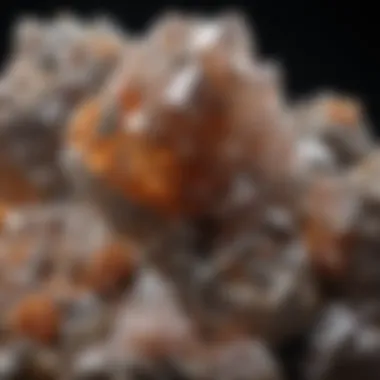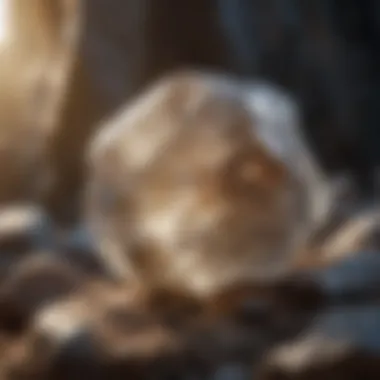Unraveling the Complexity of Quartz Rock: An In-Depth Guide for Geological Enthusiasts


Rock and Fossil Identification
Quartz rocks, with their unique crystalline structure and mesmerizing beauty, are a captivating subject for geological enthusiasts. Understanding the types of rocks and fossils is crucial in identifying quartz specimens. Quartz falls under the category of igneous rocks, characterized by its composition of silicon and oxygen. Its distinctive hexagonal crystals and glassy luster make it stand out among various rock types. When identifying quartz rocks, look for specific characteristics such as transparency, conchoidal fracture, and hardness resembling that of steel. Utilizing tools like a geologist's hammer, magnifying glass, and streak plate can aid in accurate identification.
Collecting Tips and Techniques
For amateur and seasoned collectors alike, mastering the art of quartz rock collection can be a rewarding journey. When embarking on a collecting expedition, it's essential to adhere to best practices to ensure the preservation of specimens and the safety of the collector. Prime collecting sites for quartz rocks can typically be found in areas with volcanic activity or regions rich in silica deposits. To safely extract specimens, use appropriate tools like chisels, brushes, and protective gear. Additionally, documenting the exact location and geological context of each find enhances the scientific value of the collection.
Preservation and Display
Preserving the beauty and integrity of quartz rocks is paramount for long-term enjoyment and study. Techniques such as using archival-quality containers, silica gel packs for moisture control, and protective padding can help maintain the pristine condition of specimens. Proper storage methods involve storing quartz rocks away from direct sunlight or extreme temperature fluctuations to prevent damage. Creative display ideas, such as arranging specimens by color or crystal formation, can enhance the aesthetic appeal of a rock collection while providing educational value.
Geological Insights
Delving deeper into the geological aspects of quartz rocks unveils a rich tapestry of Earth's history and natural processes. Explore the intricate formations of quartz through geological processes like crystallization within magmatic intrusions or hydrothermal veins. The historical significance of quartz rocks spans cultures and civilizations, where they were revered for their mystical properties and practical uses. Notable discoveries in the field of quartz geology include finding specimens with rare inclusions or unusual growth patterns, shedding light on the intricate world of minerals and their formation.
Introduction
In the vast realm of geological wonders, few rocks captivate the imagination quite like quartz. This section serves as the gateway to a comprehensive exploration of quartz rocks, shedding light on their enigmatic composition, origination, diverse properties, and profound significance in the domain of geology. As we embark on this journey, we will unravel the mysteries that make quartz such a fascinating subject for avid collectors and enthusiasts. From its humble beginnings to its multifaceted uses, this guide aims to provide a deep understanding of the intricacies that lie within quartz rocks.
Defining Quartz Rock
Composition of Quartz
Delving into the essence of quartz, we encounter a mineral renowned for its purity and resilience. The composition of quartz, predominantly silicon dioxide, imbues it with exceptional durability and clarity, making it a sought-after gem in various industries. Its ability to withstand high temperatures and acidic environments underlines its versatile nature, a quality that distinguishes quartz as a top choice for both scientific research and commercial applications. Despite its common occurrence in nature, the consistency and elemental structure of quartz remain unparalleled, contributing to its enduring appeal.
Structure of Quartz Crystals
Stepping into the intricate world of quartz crystals reveals a symphony of geometrical precision and elegance. The unique hexagonal crystalline structure of quartz not only showcases its exceptional symmetry but also influences its optical and energetic properties. From the orderly arrangement of silicon and oxygen atoms to the intriguing phenomena of piezoelectricity and birefringence, the intricate structure of quartz crystals plays a pivotal role in shaping its aesthetic allure and functional diversity.
Origins of Quartz
Formation Process
Unraveling the enigmatic origins of quartz unveils a journey steeped in geological nuance and complexity. The formation process of quartz involves a combination of hydrothermal activity, metamorphism, and magmatic intrusions, culminating in the crystallization of silica-rich solutions. This intricate process not only highlights the sensitivity of quartz to environmental conditions but also underscores its role as a geologically significant mineral with remarkable stability and longevity.


Geological Occurrence
The geological occurrence of quartz spans a diverse spectrum of depositional environments, ranging from sedimentary basins to hydrothermal veins. Its presence in a myriad of rock types, including igneous, metamorphic, and sedimentary formations, underscores its status as a ubiquitous mineral with global geological relevance. The interplay between tectonic forces, temperature fluctuations, and mineral interactions enriches the narrative of quartz's geological journey, offering valuable insights into Earth's dynamic history.
Properties of Quartz
Physical Properties
Exploring the physical properties of quartz unveils a treasure trove of scientific marvels and sensory delights. With a hardness of 7 on the Mohs scale, quartz boasts exceptional scratch resistance and luster, making it a favored gemstone for jewelry and ornaments. Its vitreous to greasy luster and conchoidal fracture patterns add to its visual allure, while its translucent to transparent clarity enhances its aesthetic appeal under various lighting conditions. The diverse range of color options, from milky white to smoky gray and vibrant amethyst, further accentuates the allure of quartz in the realm of mineralogy.
Chemical Makeup
Diving into the chemical makeup of quartz unravels the molecular intricacies that define its identity and behavior. Composed of silicon and oxygen tetrahedra arranged in a structured lattice, quartz epitomizes the essence of purity and stability in the mineral kingdom. Its resistance to chemical weathering and etching reflects the inherent bonds that ensure its enduring presence in diverse geological settings. The variable incorporation of trace elements, such as iron, aluminum, and titanium, introduces captivating hues and optical effects, elevating quartz from a mineral of utility to a gem of aesthetic splendor.
Characteristics of Quartz Rock
Quartz rock, with its diverse and intriguing properties, plays a pivotal role in the field of geology. Understanding the characteristics of quartz rocks is essential for enthusiasts and collectors looking to deepen their knowledge of this mesmerizing mineral. This section will delve into the various elements that define quartz rocks, highlighting their significance in geological studies and exploration. By exploring the composition, formation, and distinct features of quartz rocks, readers will gain a nuanced understanding of this geological marvel.
Varieties of Quartz
Common Types
Exploring the common types of quartz unveils a world of variation and complexity within this mineral family. From the popular clear quartz to the vibrant rose quartz, each common type offers unique attributes that cater to different preferences and geologic settings. Common types like amethyst and citrine exhibit striking hues and are prized for their beauty and metaphysical properties. Understanding the common types of quartz expands knowledge on the wide array of options available for collectors and enthusiasts, making it an essential aspect of this comprehensive guide
Rare Variants
Rare variants of quartz present a treasure trove for enthusiasts seeking unique and elusive specimens. Varieties such as rutilated quartz and phantom quartz mesmerize with their rare formations and intricate inclusions. While rare variants may be harder to find, their scarcity adds to their allure and value in geological contexts. Delving into rare variants sheds light on the exceptional characteristics that set them apart from more common types, enriching the exploration of quartz rocks in this article.
Color and Transparency
Influence of Impurities
The influence of impurities on the color and transparency of quartz rocks adds a layer of complexity to their visual appeal. Impurities like iron and titanium contribute to the diverse range of colors exhibited by quartz, from the deep purple of amethyst to the smoky hues of citrine. Understanding how impurities influence the coloration of quartz provides insight into the geologic processes that shape these mesmerizing minerals.
Optical Effects
Optical effects in quartz rocks, such as chatoyancy and asterism, create mesmerizing visual displays that captivate collectors and enthusiasts. These optical phenomena result from intriguing internal structures within quartz crystals, enhancing their aesthetic appeal and value. Exploring the optical effects of quartz not only reveals its beauty but also offers insights into its formation and unique properties, making it a compelling topic in this comprehensive guide.


Crystal Habit and Form
Morphological Features
The morphological features of quartz crystals showcase the intricate designs and formations that characterize this mineral. From the classic hexagonal prisms to complex terminations, quartz crystals exhibit a diverse array of morphologies that vary depending on environmental conditions and growth patterns. Understanding the morphological features of quartz provides valuable information about its crystalline structure and geologic history, enhancing the appreciation of this stunning mineral.
Crystal Structures
Diving into the crystal structures of quartz unveils the symmetrical arrangements and internal order that define its crystalline form. The hexagonal symmetry and trigonal crystal system of quartz contribute to its iconic shape and unique properties. Exploring the crystal structures of quartz offers insights into its physical properties and behavior under different conditions, deepening the understanding of this remarkable mineral in the realm of geology.
Utilization of Quartz
When exploring the realm of quartz rocks, it is imperative to understand the significance of their utilization. Quartz, known for its versatility and unique properties, plays a vital role in various industries and applications. From technology to manufacturing, the utilization of quartz offers a wide array of benefits and considerations for enthusiasts and collectors alike. This section will delve into the specific elements that make quartz a valuable raw material, the benefits it brings to different sectors, and essential considerations regarding its utilization.
Industrial Applications
Uses in Technology
In the domain of technology, quartz stands out for its exceptional properties, such as its piezoelectric and pyroelectric characteristics. These properties make quartz a go-to material for sensor applications, oscillators in electronic devices, and even as a component in high-tech machinery. Its stability, precision, and endurance make it a favored choice in enhancing the performance and reliability of various technological applications. Moreover, the ability of quartz to resonate at a consistent frequency further highlights its utility in technology. However, while quartz's properties offer numerous advantages, considerations such as sensitivity to extreme temperatures and fragility in some forms need to be taken into account in its technological applications.
Role in Manufacturing
Quartz's role in manufacturing processes is equally noteworthy. With its hardness and resistance to chemical corrosion, quartz is extensively used in the production of glass, ceramics, and other industrial materials. Quartz's presence in these manufacturing processes enhances the durability and quality of final products, making it an indispensable component in various industries. The unique feature of quartz, its ability to withstand high temperatures and pressure, ensures its popularity in manufacturing applications. Despite its numerous advantages, challenges like extraction costs and environmental impact should be carefully evaluated when considering quartz's role in manufacturing industries.
Metaphysical Properties
The metaphysical properties of quartz add another layer of intrigue to its allure. In the world of healing and spirituality, quartz is revered for its alleged healing qualities and spiritual significance. These aspects of quartz elevate its appeal beyond scientific and industrial realms, appealing to individuals seeking holistic well-being and spiritual connection. This section will delve into the healing properties attributed to quartz and its broader spiritual significance, shedding light on the profound influence quartz can have on individuals.
Healing Qualities
Quartz is believed by some to possess healing properties that promote physical, emotional, and spiritual balance. Its energy-clearing abilities and amplification of other crystal energies make it a popular choice among holistic healers and energy workers. Quartz's ability to absorb, store, and regulate energy is thought to enhance healing processes and promote overall wellness. While quartz's healing qualities are widely celebrated, individuals should exercise caution in interpreting and relying solely on its metaphysical effects for health purposes.
Spiritual Significance
In spiritual practices, quartz holds symbolic importance across cultures and belief systems. The crystal's ability to amplify intentions and connect individuals with higher realms is the cornerstone of its spiritual significance. Quartz is often used as a meditation tool, dream enhancer, and aid in spiritual rituals due to its purported ability to elevate consciousness and facilitate spiritual growth. Despite its spiritual benefits, individuals exploring the spiritual realm of quartz should approach its significance with respect and openness to diverse interpretations.
Ornamental Uses


Beyond its practical applications, quartz also shines in the world of aesthetics and design. Ornamental uses of quartz encompass decorative purposes and jewelry design, where the beauty and versatility of quartz crystals are showcased in various forms. This section will highlight the decorative and ornamental aspects of quartz, exploring its role in enhancing visual appeal and cultural symbolism.
Decorative Purposes
Quartz's natural beauty and wide range of colors make it a sought-after material for decorative purposes. From home decor to architectural accents, quartz finds its place in embellishing interior spaces and adding a touch of elegance. Its durability and luster make it a popular choice for countertops, tiles, and decorative objects. The unique feature of quartz lies in its ability to effortlessly complement different decor styles, from modern to traditional, offering a timeless appeal that transcends trends. While quartz's decorative purposes are vast, considerations such as maintenance requirements and proper care are essential to preserve its beauty.
Jewelry Design
In the realm of jewelry, quartz takes center stage for its beauty, versatility, and metaphysical properties. Whether in its raw form or polished to perfection, quartz crystals adorn jewelry pieces with a touch of elegance and mystique. Its numerous varieties, including amethyst, citrine, and rose quartz, cater to diverse aesthetic preferences and energetic qualities. The unique feature of quartz in jewelry design lies in its ability to enhance personal style while embracing the crystal's symbolic meanings. As individuals immerse themselves in the world of quartz jewelry, understanding the diverse uses and care instructions for these pieces becomes crucial in maintaining their aesthetic appeal and energetic properties.
Significance of Quartz in Geology
In the realm of geology, the significance of quartz cannot be overstated. Quartz plays a pivotal role as an indicator mineral, offering invaluable insights into geological processes and formations. As one of the most abundant minerals on Earth, quartz serves as a key component in various rock types, aiding geologists in understanding the intricate history and composition of the Earth's crust. Its unique properties make it a cornerstone in geology studies, influencing everything from mineral identification to environmental assessments.
Geological Importance
Indicator Mineral
Within geology, an indicator mineral such as quartz holds immense importance due to its distinct characteristics that provide crucial information about rock formations. Quartz's hardness, optical properties, and chemical composition make it a preferred choice for geologists when analyzing various rock types. Its prevalence in different geological settings helps in interpreting the conditions under which rocks were formed, contributing significantly to geological mapping and mineral exploration. However, despite its widespread presence, variations in quartz morphology and crystalline structure can present challenges in accurate mineral identification.
Formation in Rock Types
The formation of quartz in different rock types is a fascinating aspect that sheds light on the geological processes that have shaped the Earth over millions of years. Quartz can be found in igneous, metamorphic, and sedimentary rocks, each telling a unique story of its formation. Understanding the distinctive characteristics of quartz in various rock types provides valuable information about the conditions that prevailed during the rock's genesis. For instance, the presence of quartz in igneous rocks like granite signifies a slow cooling process deep within the Earth, while quartz in sedimentary rocks offers insights into the environmental conditions prevalent during deposition.
Quartz in Earth's History
Geological Time Scale
Exploring quartz within the framework of the geological time scale unveils its evolution over millions of years and its enduring presence in Earth's history. By studying quartz deposits across different geological epochs, scientists can decipher the changes that have occurred in the Earth's crust and its impact on mineral formation. Quartz serves as a reliable chronological marker, allowing geologists to date rock formations and reconstruct past geological events with precision. Its widespread distribution throughout geological time periods reflects its resilience and enduring significance in Earth's dynamic geological processes.
Implications in Paleogeography
The implications of quartz in paleogeography provide valuable clues about ancient landscapes and the environmental conditions that prevailed in the distant past. Quartz deposits in sedimentary rocks offer insights into the paleoenvironments where these rocks were deposited, helping scientists reconstruct past climate conditions and tectonic movements. The distribution patterns of quartz in different geological strata serve as a geographical puzzle that researchers piece together to unravel the Earth's geological history, highlighting the intricate interplay between landforms, climate dynamics, and geological forces.
Environmental Insights
Quartz as Environmental Recorder
Quartz's role as an environmental recorder showcases its ability to preserve valuable information about past environmental conditions. As quartz grains accumulate in sedimentary deposits over time, they capture changes in the environment, such as fluctuations in temperature, precipitation, and sedimentation rates. By analyzing quartz particles using advanced techniques, scientists can unravel significant details about ancient climates, helping in climate change studies and understanding long-term environmental trends.
Climate Change Indicators
The use of quartz as a climate change indicator stems from its sensitivity to environmental shifts and its presence in geological layers that record past climatic variations. Changes in the quartz composition and structure can provide insights into shifts in temperature, humidity, and atmospheric conditions that have occurred over geological time scales. By studying quartz deposits in conjunction with other climate proxies, researchers can reconstruct past climate patterns and assess the impact of human activities on the Earth's climate system, enhancing our comprehension of current and future climate change scenarios.







